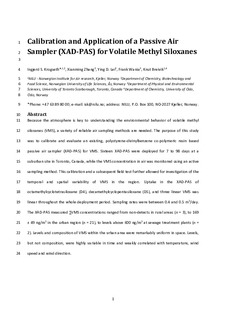Calibration and Application of a Passive Air Sampler (XAD-PAS) for Volatile Methyl Siloxanes
Journal article, Peer reviewed
Accepted version
Permanent lenke
http://hdl.handle.net/11250/2466322Utgivelsesdato
2013Metadata
Vis full innførselSamlinger
- Publikasjoner fra Cristin - NILU [1360]
- Vitenskapelige publikasjoner [1096]
Originalversjon
Krogseth, I.S., Zhang, X., Lei, Y.D., Wania, F., Breivik, K. (2013). Calibration and application of a passive air sampler (XAD-PAS) for volatile methyl siloxanes. Environmental Science and Technology, 47, 4463-4470. doi:10.1021/es400427h 10.1021/es400427hSammendrag
Because the atmosphere is key to understanding the environmental behavior of volatile methyl siloxanes (VMS), a variety of reliable air sampling methods are needed. The purpose of this study was to calibrate and evaluate an existing, polystyrene-divinylbenzene co-polymeric resin based passive air sampler (XAD-PAS) for VMS. Sixteen XAD-PAS were deployed for 7 to 98 days at a suburban site in Toronto, Canada, while the VMS concentration in air was monitored using an active sampling method. This calibration and a subsequent field test further allowed for investigation of the temporal and spatial variability of VMS in the region. Uptake in the XAD-PAS of octamethylcyclotetrasiloxane (D4), decamethylcyclopentasiloxane (D5), and three linear VMS was linear throughout the whole deployment period. Sampling rates were between 0.4 and 0.5 m3/day. The XAD-PAS measured ∑VMS concentrations ranged from non-detects in rural areas (n = 3), to 169 ± 49 ng/m3 in the urban region (n = 21), to levels above 600 ng/m3 at sewage treatment plants (n = 2). Levels and composition of VMS within the urban area were remarkably uniform in space. Levels, but not composition, were highly variable in time and weakly correlated with temperature, wind speed and wind direction.
